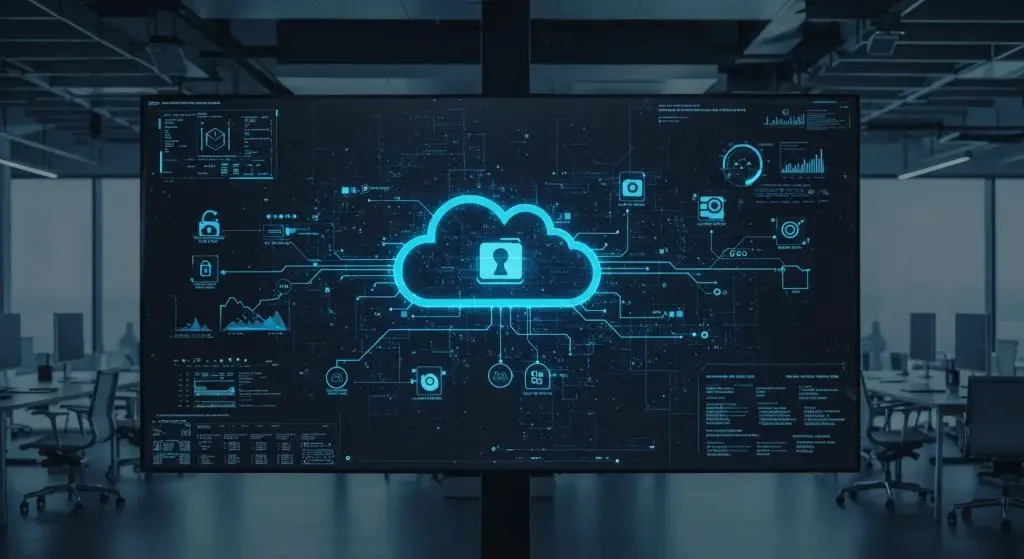Safeguard Your Data With Robust Cloud Security Measures
Cloud Security Measures That Safeguard Your Data
Cloud security is a critical concern for modern businesses. As organizations increasingly migrate their data using database managed services and applications to the cloud, they must adopt robust security measures—including managed-security-services and managed network firewall services—to protect sensitive information from cyberattacks and data breaches. This article explains how fundamental cloud security principles, essential safeguarding technologies, strong implementation measures, best practices for sustained data protection, strategic approaches for effective security, and solutions to address key challenges work together to secure cloud infrastructures. Business owners, board members, and cybersecurity executives will gain a clear understanding of how advanced cloud security measures can add value to their business by mitigating vulnerabilities and ensuring regulatory compliance.
In today’s complex technological landscape, adhering to a comprehensive cloud security strategy not only prevents costly breaches but also enables companies to maintain data integrity and business continuity. This article delves into the operational scope of cloud security, the shared responsibility model, common threats, and the technologies that offer granular protection for cloud-hosted data. It further details strategic security implementations and best practices that foster a proactive security posture across cloud environments.
Transitioning to a secure cloud environment requires an understanding of both traditional IT security and the unique aspects of cloud computing. This article illuminates these nuances, providing actionable recommendations and detailed insights into how organizations can leverage security technologies to build a resilient cloud security strategy.
Key Takeaways
- Cloud security measures integrate multiple layers of protection, ensuring data confidentiality, integrity, and availability.
- Essential technologies like IAM, encryption, and SIEM help manage and mitigate risks in cloud environments.
- Implementing a strong cloud security framework involves strategic planning, continuous monitoring, and adherence to regulatory standards.
- Adopting best practices such as multifactor authentication, robust backup procedures, and regular security assessments is crucial.
- Overcoming challenges related to multi-cloud deployments and skill shortages requires a proactive, strategic approach.
Grasping Fundamental Cloud Security Principles

Understanding cloud security is imperative for any organization utilizing cloud computing. The first step is recognizing its operational scope. Cloud security encompasses the policies, controls, procedures, and technologies that work together to protect cloud-based systems, data, and infrastructure. It goes beyond basic network protection and includes everything from application security to data governance.
Defining Cloud Security and Its Operational Scope
Cloud security refers to the framework of safeguards that protect data, applications, and infrastructure in the cloud. It involves several dimensions such as physical security of data centers, logical security controls including identity and access management (IAM), application security, and configuration management. These components ensure data integrity, confidentiality, and availability while also reducing operational risks. For example, access controls restrict who can view or modify data, while encryption ensures that in-transit and at-rest data remains unreadable to unauthorized users.
Additionally, cloud security covers compliance with international standards like ISO/IEC 27001 and frameworks provided by the Cloud Security Alliance. This scope extends further to regulatory compliance, where organizations must meet specific industry and geographic mandates such as the California Consumer Privacy Act (CCPA). As a result, businesses adopt layered security strategies that integrate best practices from both traditional IT security and cloud-specific requirements.
Understanding the Shared Responsibility Model in Cloud Settings
One of the fundamental pillars of cloud security is the shared responsibility model. In cloud computing, security obligations are distributed between the cloud service provider and the client organization. Typically, providers handle physical security and infrastructure-level safeguards, while customers are responsible for securing data, managing user access, and applying application-level controls. This model clarifies which aspects of security lie with the vendor and which require internal controls, ensuring a comprehensive approach to threat management.
For instance, while a provider may offer secure serverinfrastructure and robust encryption for data transmission, it is the client’s duty to manage sensitive data appropriately through access rules and ongoing vulnerability assessments. This collaborative approach minimizes the risk of breaches by ensuring that every layer of the cloud environment is protected through coordinated efforts.
Recognizing Common Threats to Your Cloud-Hosted Data
Cloud environments are susceptible to a range of threats. Cyberattacks such as Distributed Denial of Service (DDoS), malware injections, phishing campaigns, and unauthorized access often target vulnerabilities in configuration or user practices. Inadequate identity management and insecure application interfaces can lead to significant data loss. Additionally, misconfigurations and lack of continuous monitoring can expose systems to risk, enabling malicious actors to exploit gaps in cloud security.
Understanding these risks is critical as companies plan to counter threats with proper protocols. Regular vulnerability assessments and penetration tests serve as preventive measures, identifying weaknesses in cloud configurations before attackers can exploit them. Moreover, educating employees on potential phishing schemes and social engineering tactics remains a vital element in combating cyber threats.
The Importance of Proactive Cloud Security Posture Management
Effective cloud security is built on proactive security posture management. This proactive approach involves continuous monitoring, rapid threat detection, and real-time responses to potential breaches. Tools such as Security Information and Event Management (SIEM) facilitate the aggregation and analysis of logs, providing actionable insights that help security teams identify anomalies and potential incidents early.
Cloud security posture management (CSPM) solutions automate these assessments, enabling organizations to continuously evaluate their security configurations against industry standards and best practices. Such systems provide real-time compliance monitoring and vulnerability management, ensuring that even minor misconfigurations are quickly addressed to prevent exploitation.
Distinguishing Cloud Security From Traditional IT Security
While both cloud and traditional IT security aim to protect digital assets, cloud security requires additional layers due to its distributed and scalable nature. Traditional IT security typically focuses on on-premise network protections, such as firewalls and intrusion detection systems. However, cloud environments rely heavily on dynamic and scalable solutions that can rapidly respond to changing threats.
For example, cloud security leverages advanced analytics and machine learning to monitor user activity and detect potential breaches across vast distributed networks. As a result, strategies such as zero trust security become essential, where no user or device is trusted by default. This contrasts with traditional approaches that often relied on perimeter defenses. Understanding these distinctions is crucial for organizations seeking to adopt effective cloud security measures while managing both legacy and cloud-native systems.
Essential Technologies for Safeguarding Your Cloud Data

Modern cloud security leverages a host of advanced technologies designed to protect data across all layers of the cloud infrastructure. These technologies enable organizations to monitor, analyze, and respond to unprecedented security challenges. Integrating these platforms not only safeguards sensitive data but also ensures compliance with regulatory standards and best practices.
Utilizing Identity and Access Management for Secure Access
Identity and Access Management (IAM) is a foundational technology in cloud security. IAM systems help ensure that only authorized individuals can access specific data and applications within the cloud infrastructure. This technology enables businesses to enforce least privilege policies, reducing redundancy and narrowing potential attack surfaces. By configuring multifactor authentication (MFA) and role-based access controls (RBAC), organizations can significantly enhance security. These measures mitigate risks associated with stolen credentials and unauthorized data manipulation.
IAM also integrates with other cloud security solutions, such as SIEM, to provide real-time alerts and extensive auditing capabilities. For example, automated policies can flag unusual login attempts or access from unknown geographical locations. This immediate detection helps prevent potential breaches before they escalate into critical incidents. Additionally, cloud IAM platforms offer centralized dashboards that provide granular visibility into user access patterns—critical for compliance with standards like the General Data Protection Regulation (GDPR).
Applying Data Encryption Methods to Protect Sensitive Information
Data encryption is a critical line of defense against cyberattacks. In cloud environments, encryption protects data both at rest and in transit. Implementing robust encryption protocols helps ensure that even if data is intercepted, it remains unreadable to unauthorized users. Organizations often utilize encryption standards such as AES-256 for data at rest and TLS (Transport Layer Security) for data in transit, which significantly reduces risks associated with data breaches.
Encryption also plays a vital role in maintaining regulatory compliance. Many industries require encryption as part of the security controls mandated by regulatory bodies. Proper key management, which involves secure storage and timely rotation of cryptographic keys, is essential to maintaining the integrity of the encryption process. Advanced encryption methodologies, paired with cloud-native key management services (KMS), enable seamless integration of this security layer with other cloud services.
Deploying Cloud Workload Protection Platforms
Cloud Workload Protection Platforms (CWPPs) provide extensive security for applications and workloads deployed in the cloud. These platforms combine traditional endpoint security with cloud-native capabilities to offer comprehensive protection. CWPPs detect and respond to anomalous behavior in real time, ensuring that vulnerable workloads receive appropriate remediation. By integrating machine learning and behavioral analytics, CWPPs can identify emerging threats and isolate compromised instances before they affect the entire environment.
Moreover, CWPPs facilitate compliance reporting and continuous security monitoring, which are essential components of an effective cloud security strategy. Their ability to operate across various cloud service models, including Infrastructure as a Service (IaaS), Platform as a Service (PaaS), and Software as a Service (SaaS), makes them indispensable in maintaining a secure and resilient cloud infrastructure.
Leveraging Security Information and Event Management for Threat Insights
Security Information and Event Management (SIEM) systems are at the heart of proactive cloud security. SIEM tools collect and analyze security logs from multiple sources within the cloud environment, offering centralized visibility and contextual threat insights. By aggregating events, SIEM systems facilitate correlation and analysis, enabling rapid incident detection and response. They utilize advanced analytics to spot patterns indicative of malicious activities, which may otherwise be overlooked in isolated systems.
The integration of SIEM with cloud applications allows teams to monitor critical events, such as unauthorized access attempts and configuration changes, in near real time. This immediate intelligence aids in establishing an effective incident response plan. Furthermore, SIEM solutions support compliance audits by maintaining detailed records of security events, which are necessary for demonstrating adherence to cybersecurity frameworks like the NIST Cybersecurity Framework.
Employing Cloud Access Security Brokers for Policy Enforcement
Cloud Access Security Brokers (CASBs) represent an important technology for enforcing security policies in the cloud. CASBs act as intermediaries between cloud service users and cloud applications, monitoring data transfers and ensuring that security policies are uniformly applied. They provide granular control over data access and usage, which is vital in preventing data leaks and ensuring that only compliant applications access sensitive information.
CASBs can enforce encryption policies, track user activity, and provide real-time alerts about suspicious behavior. For example, if an employee attempts to download confidential files to an unapproved device, the CASB can block the transaction and log a security incident. By integrating with on-premises and cloud-based infrastructures, CASBs offer unparalleled visibility into data flows, facilitating proactive security management and mitigating risks associated with shadow IT.
Implementing Strong Cloud Security Measures Across Infrastructure

When it comes to securing cloud infrastructure, implementing robust security measures across all components is essential. From secure network configurations to ongoing security assessments, each layer of the infrastructure must be fortified to reduce vulnerabilities and prevent breaches. This section outlines practical steps to establish a strong security foundation.
Establishing Secure Network Configurations to Shield Data
Secure network configurations form the backbone of a resilient cloud security posture. Establishing strict network segmentation, robust firewall policies, and secure VPNs to enable protected remote access is critical for defending against unauthorized intrusions. Using virtual private clouds (VPCs) and employing microsegmentation techniques help isolate resources and limit the potential spread of a breach.
Moreover, employing security groups and network access control lists (ACLs) restricts access based on IP addresses and protocols, ensuring that only legitimate traffic reaches sensitive systems. By integrating network configuration tools with automated audits, organizations can detect misconfigurations in real time and apply remediation measures before vulnerabilities are exploited. This proactive management is essential in a dynamic environment where continuous changes to cloud resources require ongoing vigilance.
Effective network configuration also involves leveraging encryption for data in transit. Transport Layer Security (TLS) protocols ensure that communications between cloud components are secure, preventing man-in-the-middle attacks. Additionally, organizations should consider deploying robust intrusion detection and prevention systems (IDPS) to monitor network traffic for anomalies. Collectively, these measures significantly contribute to a secure cloud network that acts as a strong barrier against cyber threats.
Fortifying Application Security in Cloud Environments
Application security in the cloud involves several layers of defense. Developers must ensure that applications adhere to secure coding practices, employ rigorous testing, and receive regular updates to mitigate vulnerabilities. Incorporating automated security scanning tools into the software development lifecycle (SDLC) is vital to detect and address vulnerabilities early in the process.
Furthermore, implementing a secure API gateway fortifies the interface between applications and services, controlling access and preventing unauthorized data exposure. Application layer firewalls provide additional protection by filtering malicious payloads, while continuous integration and continuous deployment (CI/CD) pipelines facilitate rapid updates and security patches. This approach not only reduces the attack surface but also ensures that applications remain resilient against emerging threats.
Robust application security also emphasizes multi-factor authentication (MFA) and role-based access controls (RBAC), ensuring that only authorized users can access critical application functions. Additionally, organizations should integrate logging and monitoring solutions to capture application activity, enabling thorough post-incident analysis and continuous improvement. These combined efforts help create a secure environment where applications can operate without exposing sensitive data to potential breaches.
Instituting Regular Security Assessments and Penetration Tests
No security framework is complete without regular assessments and penetration tests. These evaluations help identify vulnerabilities in cloud configurations, applications, and network setups before attackers exploit them. Scheduled security audits, vulnerability scans, and third-party penetration testing provide critical insights into the current security posture and highlight areas requiring remediation.
Organizations should conduct comprehensive risk assessments that encompass all layers of cloud infrastructure. By simulating real-world attack scenarios, penetration tests reveal weaknesses in security controls and configuration management practices. The findings from these assessments drive strategic decisions and help implement corrective measures, such as patch management and enhanced user access protocols. Regular security evaluations are essential to ensuring that the cloud environment adapts to evolving threats and maintains compliance with regulatory standards.
In addition to scheduled assessments, continuous monitoring systems complement periodic audits by detecting abnormalities in real time. Tools that leveragemachine learning and behavioral analytics can correlate disparate events to identify potential threats instantly. These insights enable security teams to respond promptly, reducing the window of opportunity for attackers. Overall, regular security assessments and penetration tests form a dynamic feedback loop that is essential for maintaining a secure cloud infrastructure.
Developing Robust Incident Response Plans for Cloud Breaches
A well-structured incident response plan is crucial for minimizing the impact of cloud security breaches. Such plans incorporate defined roles, clear communication protocols, and automated response mechanisms to handle security incidents swiftly and efficiently. Establishing an incident response team with diverse expertise ensures that all aspects of a breach—from detection to recovery—are managed effectively.
Incident response plans should detail procedures for isolating affected components, backing up critical data, and restoring services. Regular training exercises and simulations help teams familiarize themselves with the plan and identify gaps in the existing strategy. Integrating incident response with broader business continuity plans ensures that disruptions are minimized, and recovery steps are promptly implemented. This comprehensive approach not only reduces downtime but also helps maintain stakeholder trust during potential security incidents.
Moreover, documenting lessons learned from past incidents is essential to improve future responses. A robust incident response plan builds resilience, enabling organizations to quickly adapt to new threats and ensure that the impact of any breach is contained. With clear action protocols and prepared response teams, businesses can maintain operational continuity even in the face of advanced cyberattacks.
Ensuring Continuous Monitoring to Detect and Respond to Threats
Continuous monitoring is an indispensable component of cloud security. Deploying automated monitoring tools enables real-time visibility into all aspects of the cloud environment, from network activity to application performance. These systems detect deviations from normal behavior, allowing security teams to rapidly respond to potential threats.
Monitoring platforms integrate with SIEM systems to aggregate data from various sources, providing a centralized overview of security events. This integration improves the speed and accuracy of threat detection, facilitating proactive measures that prevent breaches before they materialize. Furthermore, continuous monitoring supports compliance with industry standards as organizations maintain an ongoing record of security events, which is useful during audits and regulatory reviews.
The implementation of automated alert systems ensures that any suspicious activity is immediately brought to the attention of the incident response team. By leveraging machine learning algorithms, these tools continuously refine their ability to identify emerging patterns associated with attacks. Overall, continuous monitoring provides a dynamic security perimeter that adapts to evolving threats, ensuring that organizations remain one step ahead of attackers.
Adopting Best Practices for Sustained Cloud Data Protection

Sustaining robust cloud data protection requires a strategic and methodical approach. Organizations must embrace best practices that span technical implementations to comprehensive policies, ensuring that every segment of their cloud environment is consistently safeguarded. This section outlines proven methods that contribute to a secure, resilient, and compliant cloud ecosystem.
Enforcing Multi-Factor Authentication and Authorization
Multi-factor authentication (MFA) and stringent authorization protocols are the cornerstones of preventing unauthorized access to sensitive cloud data. By requiring users to provide multiple forms of verification, MFA significantly reduces the likelihood of breaches stemming from compromised credentials. This additional authentication step, combined with role-based access controls, ensures that access is granted only to individuals with a legitimate need.
Implementing MFA across cloud applications and services addresses vulnerabilities posed by password reuse and weak passwords. Coupling MFA with robust authorization mechanisms ensures that even if an identifier is compromised, the attacker cannot gain unauthorized access without the secondary factors. This layered defense is critical for maintaining data security and preventing lateral movements within the cloud infrastructure. Organizations that enforce these practices report a measurable decrease in unauthorized access incidents and improved compliance with regulatory mandates.
Furthermore, integrating MFA with centralized identity management systems streamlines user provisioning and revocation, thus reducing administrative overhead. This practice not only strengthens security but also enhances operational efficiency, as it simplifies the process of managing user identities across multiple cloud platforms. Ultimately, enforcing MFA becomes an effective deterrent against social engineering attacks and credential-based intrusions.
Maintaining Comprehensive Data Backup and Recovery Procedures
Data backup and recovery procedures are essential to mitigating the impact of cyberattacks and ensuring business continuity. Regularly scheduled backups protect against data loss from cyber incidents, hardware failures, or accidental deletions. In cloud environments, backups should be automated, encrypted, and stored in geographically diverse locations to provide redundancy and resilience against disasters.
A robust backup strategy involves creating multiple copies of critical data and ensuring that recovery points are maintained at frequent intervals. This approach minimizes data loss and reduces downtime during recovery efforts. Organizations that employ comprehensive backup solutions can rapidly restore operations after an incident, thereby minimizing the financial and reputational impact of data breaches. Moreover, testing recovery procedures regularly ensures that backup systems function as intended when needed most.
Cloud storage solutions offer scalable backup options that adapt to the growing data needs of businesses. By integrating backup management with monitoring systems, organizations can receive real-time alerts when key metrics deviate from the norm, ensuring proactive maintenance of the backup environment. This comprehensive approach to data backup and recovery is a vital component of any cloud security strategy, protecting both data integrity and organizational continuity.
Training Teams on Cloud Security Awareness and Safe Practices
Human error remains one of the most significant risks in cloud security. Investing in training and awareness programs equips employees with the knowledge needed to recognize and mitigate potential threats. Training sessions should cover topics such as phishing prevention, secure password practices, proper handling of sensitive information, and recognizing the signs of a security breach. Well-trained teams serve as a critical line of defense, reducing the risk of security incidents caused by inadvertent mistakes.
Regular security awareness training fosters a culture of vigilance and encourages employees to adopt best practices both inside and outside the organization. This proactive approach can significantly reduce the number of security incidents and enhance the overall security posture. Additionally, organizations should provide updated training materials whenever new security threats emerge or when significant changes are made to the cloud infrastructure. By continuously educating teams on evolving security risks, companies not only improve their resilience against attacks but also ensure that all employees act as conscientious stewards of corporate data.
Adhering to Data Privacy Regulations and Compliance Standards
Compliance with data privacy regulations is not optional in today’s regulatory environment. Business operations must adhere strictly to industry standards such as GDPR, CCPA, and other relevant regulations. Adherence to these standards ensures that data processing practices are secure and that sensitive information is not exposed to unauthorized parties. Compliance also safeguards organizations from potentially crippling financial penalties and reputational damage following a data breach.
Regulatory compliance requires establishing clear data handling protocols, provenance, and access logging mechanisms. It is essential for businesses to conduct regular compliance audits and integrate compliance requirements into their security policies. Streamlined compliance not only improves data security but also reinforces customer trust by demonstrating a commitment to protecting personal and sensitive information. The use of automation in compliance management can further enhance security by reducing the possibility of human error and ensuring that policies are enforced consistently across the organization.
Periodically Reviewing and Refining Security Policies for Data Safety
Security policies should never remain static. The dynamic nature of cloud environments necessitates continuous review and refinement of security controls. Regular evaluations of security policies, based on both internal audits and external industry standards, ensure that policies remain relevant and effective against emerging threats. Refining policies may involve updating access controls, revising incident response procedures, or integrating new technologies that enhance data protection.
Periodic policy reviews serve to identify gaps in the security framework and allow organizations to adapt to changing threat landscapes. By incorporating feedback from security assessments and industry best practices, companies can implement measures that are both proactive and resilient. This continuous improvement process is a hallmark of a mature security strategy, enabling businesses to evolve their cloud security posture in tandem with technological advancements. Regularly refined security policies ensure that data safety remains a top priority and that potential vulnerabilities are continuously addressed.
Formulating Strategic Approaches for Effective Cloud Security

Strategic planning is essential to building an effective cloud security framework. Organizations must align their security initiatives with overall business goals and adopt models that continuously assess and mitigate risks. This section explores strategic approaches that enable businesses to integrate security seamlessly into their operations, from zero trust frameworks to integrating security into the software development lifecycle.
Aligning Your Cloud Security Strategy With Business Goals
For a cloud security strategy to be effective, it must be aligned with the broader business objectives of the organization. This alignment ensures that security measures not only protect data but also support business growth and operational efficiency. Developing a cloud security strategy begins with understanding the business’s critical assets, regulatory obligations, and risk tolerance levels. Through this understanding, organizations can design security policies that balance protection with usability and performance.
Strategic alignment involves defining clear security metrics and integrating these metrics into performance assessments across the company. For example, establishing key performance indicators (KPIs) related to incident response times, vulnerability assessment completions, and compliance audit scores can help demonstrate the value of the security program to stakeholders. When the security strategy aligns with business goals, investments in security technologies yield greater returns through enhanced operational resilience and reduced risk exposure.
Moreover, aligning the security strategy with business goals fosters a culture where security is viewed as an enabler rather than an obstacle. This perspective encourages collaboration between IT departments, business units, and executive leadership, thereby ensuring that security initiatives receive the necessary support and resources. Ultimately, this alignment creates a more unified organizational approach to managing risk and sustaining growth.
Building a Zero Trust Security Model for Cloud Assets
A Zero Trust security model is emerging as one of the most effective paradigms for protecting cloud assets. Zero Trust operates under the principle that no user or device should be inherently trusted, regardless of whether it resides inside or outside the organizational perimeter. This model requires continuous verification of every individual and device attempting to access network resources.
Implementing Zero Trust in a cloud environment involves segmenting the network into smaller, isolated zones based on sensitivity and risk. Each zone has rigorously enforced access controls, and every access request undergoes strict authentication and authorization processes. By adopting Zero Trust, organizations minimize the possibility of lateral movement in the event of a breach, as each component must prove its legitimacy independently.
Zero Trust security frameworks integrate seamlessly with cloud-native tools such as advanced IAM systems, SIEM, and CASBs. These systems collectively enforce policies that dynamically adjust access based on context, such as userbehavior and current threatintelligence. This strategic approach not only strengthens security but also provides detailed visibility into access patterns, facilitating proactive threatdetection and response. As cloud environments continue to evolve, Zero Trust remains a critical strategy for protecting digital assets in an era of increased cyber threats.
Integrating Security Throughout the Software Development Lifecycle
Security is most effective when it is embedded into every phase of the development lifecycle. Integrating security measures into the Software Development Lifecycle (SDLC) ensures that vulnerabilities are identified and mitigated during the design, development, testing, and deployment stages. This practice, often referred to as DevSecOps, incorporates security right from the start, thereby reducing overall risk and the cost of remediation later in the process.
In cloud environments, integrating security into DevOps workflows involves using automated tools for code scanning, continuous integration, continuous deployment (CI/CD), and container orchestration. These tools help detect security flaws in real time and ensure that security best practices are maintained throughout development. By fostering a culture of security awareness among developers and operations teams, organizations can reduce common vulnerabilities and expectations of rapid code changes without sacrificing safety.
Integrating security into the SDLC also supports compliance efforts, as it creates a documented trail of security measures and testing procedures that can be audited. In an increasingly complex threatlandscape, embedding security into every stage of development provides a robust defense that scales with the organization’s needs, ensuring that all cloud applications remain secure and resilient.
Choosing Cloud Service Models With Security Implications in Mind
Different cloud service models—Infrastructure as a Service (IaaS), Platform as a Service (PaaS), and Software as a Service (SaaS)—offer varying levels of security responsibility. When formulating a cloud security strategy, it is crucial to consider the security implications of each service model. For example, in an IaaS scenario, organizations bear more responsibility for securing the operating system, middleware, and applications. In contrast, SaaS models shift much of the security responsibility to the provider, though organizations remain responsible for data and access management.
Choosing the right service model involves evaluating potential risks, compliance requirements, and control needs. Security features such as encryption, access management, and continuous monitoring may vary significantly across platforms. Effective due diligence and risk assessments allow organizations to select the combination of services that best aligns with their security posture and operational objectives. This tailored approach ensures that security measures are implemented where they are most needed, offering a robust defense that is cost-effective and targeted.
Designing Scalable Cloud Security Architectures to Safeguard Your Data
As businesses grow, their cloud infrastructure must be able to scale without compromising security. Designing scalable cloud security architectures involves planning for future expansion, ensuring that security controls can adapt to increased data volume, greater user access, and evolving threat landscapes. Architects must consider scalability from the outset, integrating modular security components that can be expanded across additional resources as the organization grows.
A scalable architecture supports integration with advanced monitoring tools, SIEM systems, and threatintelligence platforms that can analyze expanded datasets in real time. This design approach not only minimizes latency in threat detection but also ensures that security policies remain effective as the organization’s cloud footprint evolves. By adopting flexible and scalable security measures, organizations can confidently expand their digital operations, knowing that robust protections are in place to safeguard their data assets.
Addressing Key Challenges in Your Cloud Security Implementation

Implementing cloud security measures is a complex endeavor that presents various challenges. From managing security in multi-cloud environments to controlling costs and addressing skills shortages, organizations must navigate numerous obstacles to achieve robust data protection. In this section, we detail the key challenges and discuss practical strategies to overcome them.
Managing Security Consistently in Multi-Cloud and Hybrid Deployments
Multi-cloud and hybrid environments introduce significant complexity in maintaining consistent security policies. Each cloud provider may implement its own set of security practices and interfaces, making it challenging to enforce uniform policies across all platforms. Organizations often face difficulties in integrating disparate systems, managing access controls, and monitoring network traffic across multiple environments.
To mitigate these challenges, adopting centralized security management tools can provide a unified view of the entire cloud infrastructure. Solutions such as Cloud Security Posture Management (CSPM) enable organizations to continuously assess security configurations across providers, identify misconfigurations, and ensure compliance with industry standards. This centralized approach simplifies complexity by automating policy enforcement and consolidating security monitoring, thereby reducing the risk of gaps or inconsistencies across multi-cloud deployments.
Moreover, developing a comprehensive multi-cloud strategy, including clear guidelines for access and data handling across different platforms, fosters a cohesive security posture. Continuous training and collaboration among IT teams are also critical to ensure that security measures are consistently applied throughout diverse cloud environments. By addressing these challenges head on, organizations can achieve a secure and cohesive cloud infrastructure.
Overcoming the Cloud Security Skills Shortage
A significant barrier to effective cloud security implementation is the persistent shortage of skilled cybersecurity professionals. Many organizations struggle to recruit and retain talent that possesses the specialized expertise required to manage complex cloud environments. This skills gap can hinder the development and maintenance of robust security operations, leading to delays in vulnerability assessments and incident response.
To overcome this challenge, companies must invest in continuous employee training and certification programs that focus on cloud security technologies and best practices. Partnering with managed security service providers (MSSPs) or leveraging outsourced security operations can also mitigate the impact of the skills shortage, ensuring that critical security functions remain operational. Additionally, automation and orchestration tools can streamline routine security tasks, reducing the burden on in-house teams and allowing them to concentrate on more complex challenges.
By addressing the skills shortage through strategic investments in workforce development and outsourcing, organizations can build a resilient security team equipped to handle the dynamic demands of cloud environments.
Controlling the Financial Aspects of Cloud Security Solutions
Implementing comprehensive cloud security measures often involves substantial financial investments, from purchasing advanced technologies to hiring specialized personnel. Budget constraints can hinder an organization’s ability to deploy and maintain cutting-edge security solutions. Cost management must be balanced with the need for robust protection, ensuring that financial resources are allocated efficiently without sacrificing security.
One effective strategy is to adopt a risk-based approach to cloud security. This involves prioritizing investments based on the potential impact of a breach, ensuring that resources are focused on protecting the most critical assets. Additionally, leveraging scalable security services and cloud-native solutions can reduce capital expenditures by shifting costs to operational expenses through subscription models. Outsourcing certain security functions to MSSPs can further help control costs while providing access to specialized expertise.
Regular financial reviews and cost-benefit analyses enable organizations to optimize their security spending. By monitoring the effectiveness of security investments and adjusting budgets based on emerging threats and performance metrics, companies can maintain an optimal balance between cost and protection.
Adapting to New Cloud Threats and Technological Changes
The rapid evolution of cloud technologies constantly introduces new threats and vulnerabilities. As attackers continually refine their techniques, organizations must be agile in updating their security measures. Staying ahead in this dynamic environment requires a commitment to ongoing research, continuous improvement, and rapid response to emerging risks.
To adapt effectively, organizations should invest in threatintelligence platforms that provide real-time insights into the latest attack vectors and vulnerabilities. Continuous security assessments, combined with an agile security framework, enable rapid response to new threats and proactive mitigation strategies. Regular updates to incident response plans and periodic policy reviews ensure that the security framework evolves in line with technological advancements.
Moreover, collaboration with industry peers and participation in cybersecurity forums can offer valuable insights into emerging trends and best practices. Continuous innovation and adaptation are critical to maintaining a secure cloud environment amidst an ever-changing threatlandscape.
Automating Security Tasks for Improved Efficiency and Reliability
Automation is a key factor in addressing the complexity and scale of cloud environments. Automating routine security tasks—such as vulnerability scanning, patch management, and compliance auditing—reduces the likelihood of human error and ensures timely execution of critical processes. Automation also enables security teams to respond to incidents faster, improving overall system reliability and reducing the window of vulnerability.
Implementing automated security solutions, such as SIEM and CSPM tools, provides consistent, real-time monitoring and remediation. By reducing the manual workload, organizations can reallocate their cybersecurity resources to more strategic tasks that require human judgment. Automation not only improves the efficiency of security operations but also enhances their accuracy, ensuring that every aspect of the cloud environment is continuously monitored and protected.
This shift toward automation is complemented by artificial intelligence (AI) and machine learning (ML) techniques, which further refine threatdetection and response capabilities. As cloud environments grow more complex, automated security tasks become indispensable for maintaining a robust, responsive, and resilient security posture.
Frequently Asked Questions
Q: What is the shared responsibility model in cloud security? A: The shared responsibility model divides security obligations between the cloud service provider and the customer. Providers handle infrastructure security while customers manage data protection, access controls, and application security, ensuring comprehensive risk management.
Q: How do security information and event management (SIEM) systems enhance cloud security? A: SIEM systems aggregate and analyze logs from various sources to detect anomalies in real time, providing centralized threat intelligence and supporting rapid incident response, which strengthens overall cloud security.
Q: Why is multi-factor authentication critical for cloud security? A: Multi-factor authentication provides an additional layer of verification, reducing the risk that unauthorized users can access sensitive cloud data even if passwords are compromised, thereby enhancing overall security.
Q: How can organizations manage security in multi-cloud environments? A: Organizations can manage multi-cloud security by adopting centralized management tools, utilizing CSPM solutions, and establishing consistent security policies across different platforms. This approach ensures uniform protection and simplifies monitoring across diverse environments.
Q: What role do cloud access security brokers (CASBs) play in cloud security? A: CASBs act as intermediaries between cloud service users and cloud applications, enforcing security policies and providing granular control over data access. They monitor and block unauthorized activities, ensuring that security measures remain consistent throughout the cloud environment.
Final Thoughts
Cloud security measures are essential for protecting data in today’s digital landscape. By understanding fundamental principles, deploying advanced technologies like IAM, SIEM, and CASBs, and implementing robust best practices, organizations can create a resilient defense against increasingly sophisticated cyber threats. A strategic approach that aligns security with business goals ensures both protection and compliance. With continuous monitoring, automation, and regular policy reviews, businesses can confidently safeguard their cloud environments while driving digital transformation and growth.



